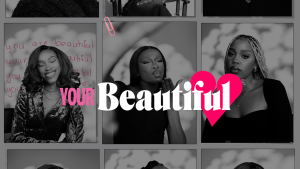AFROPUNK festival has become a celebration of self-expression through music and art. One aspect of the festival that holds the attention of people is the outfits that people wear. These outfits have become as symbolic of the AFROPUNK movement as those who perform and share their creative practices. I had a conversation with five of Johannesburg’s most fashionable creatives about their sense of style, and how this has been translated into an outfit they would wear to AFROPUNK.
Multidisciplinary artist, Anne-Marie Kalumbu embraces a style that is a combination of punk and hip hop influences. Having lived in multiple places, the city of Johannesburg has made an impression on how she chooses to present herself to those around her. With self-expression and healing at the core of how she approaches the various aspects of her artistic practice, as well as the core of how she approaches life, this seeps into her sense of style. Recognizing the fluid nature of what it means to be an inhabitant of this city, Anne Marie expressed that, “My style is more a reflection of how I am feeling at the time rather than a reflection of who I am.” Taking on the look of a revolutionary mystic queen, Anne-Marie’s outfit embodies the foundation of AFROPUNK – celebration and self-expression.

Bee Diamondhead is a stylist, art director and all round fashion guru whose name has become embedded into Johannesburg’s fashion and youth culture imagery. When asked how she would describe her style, Bee stated, “I wear what I like”. This statement closely echoes the title of the book I Write What I Like – a collection of writing and speeches by the South African activist and black consciousness leader Steve Biko. In a sense, this statement echoes the sentiments behind the title too. Similar to Anne-Maries, Bee explains that how she feels in the moment is an important factor in determining what she wears. “Sometimes I feel like a boss bitch so lately I have been wearing a lot tailored suits. Double-breasted tailored suits. But then I still feel super sexy so I will wear them with literally nothing underneath, and just like a lacey bra…But it’s a little schizophrenic. There is not distinct direction or look that I go for. But now that I am older I wear a lot less prints and a lot less colour.” Vogue Australia’s fashion editor Christine Centenera and the street style of people at home who live in more urban or rural areas have a large influence on her, allowing her to embrace a kind of ghetto, out of the box understanding of pairing clothes. This can be seen in how she has combined high-top vans and a fanny pack with a headwrap and an African print dress in the outfit she imagines herself in for AFROPUNK.

One half of the music and creative duo FAKA, Desire Marea, has had an impact not only on defining music and performance, but has also become influential for his sense of style. Tapping into the past and future spirit of Fela Kuti, with the modern twist injected a resonance with Ib Kamara, his outfits and approach to fashion is admirable. “My style is a Cunty Queen Moroka Aesthetic,” Desire explains. When asked to unpack this by explaining who influences this aesthetic, he expands by stating, “My mother, Queen Moroka, and Black People are my main influences.” This connection between femme energy and people of colour amalgamates into a powerful declaration which can be seen with every outfit he wears. “My style is a reflection of my truest identity. I dress my body in things that vibrate on the same level as my soul.” His AFROPUNK outfit allows for a feeling of confidence that lets the body pulsate to feminine translations of Bubblegum and Kwaito.
Transgender model Elle constructs clean, yet playful stylistic choices. “I enjoy playing with shapes and texture, while also staying in the confines of trends,” she explains. For Elle, the street style in countries like Japan and South Korea has moved up in her list of style influences due to the way in which gender specific clothing and dressing has been discarded. “That stuff is super inspiring to me!” she expresses,” Locally, I’m a huge fan of Mathe Ribane and everything she does with style! But, I mean who isn’t?” Elle’s AFROPUNK outfit repeats this interpretation of style by working with oversized items and flowing fabric.

Photographer and blogger Trevor Stuurman is another veteran in South Africa’s fashion scene, with prints being the signature of his Afrocentric style. For him, wearing and supporting fashion made by African labels is incredibly important. “I love celebrating the continent that I come from and that I am so proud of. And I think that it is important for us to wear where we come form on our sleeves before anyone else does, ” Trevor expressed. For him how he dresses should be a conversational piece, allowing for the sharing of knowledge about local fashion and textile designers. “Our bodies are the most natural platforms we have, and we should always use them to celebrate and uplift others.” Trevor’s AFROPUNK outfit holds on to the core of this fashion identity, while simultaneously ensuring that his clothing is practical.






